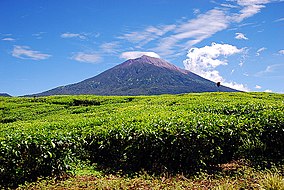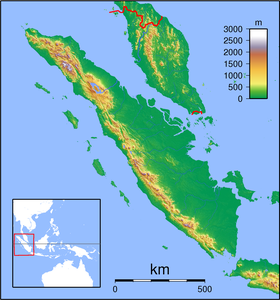Kerinci Seblat National Park
| Kerinci Seblat National Park | |
|---|---|
| Taman Nasional Kerinci Seblat | |
|
IUCN category II (national park)
|
|

Mount Kerinci in Kerinci Seblat National Park
|
|
|
Location in Sumatra
|
|
| Location | Sumatra, Indonesia |
| Coordinates | 2°25′S 101°29′E / 2.417°S 101.483°ECoordinates: 2°25′S 101°29′E / 2.417°S 101.483°E |
| Area | 1,375,000 ha (5,310 sq mi) |
| Established | 1999 |
| Governing body | Ministry of Environment and Forestry |
| World Heritage Site | 2004 |
| Website | kerinciseblat.dephut.go.id |
| Official name | Tropical Rainforest Heritage of Sumatra |
| Type | Natural |
| Criteria | vii, ix, x |
| Designated | 2004 (28th session) |
| Reference no. | 1167 |
| State Party | Indonesia |
| Region | Asia-Pacific |
| Endangered | 2011–present |
Kerinci Seblat National Park is the largest national park on the island of Sumatra, Indonesia. It has a total area of 13,791 km2, and spans four provinces: West Sumatra, Jambi, Bengkulu, and South Sumatra.
It is located between 100°31'18"E - 102°44'01"E and 1°07'13"S - 3°26'14"S.
The park area includes a large part of the Barisan mountain range, which form the western spine of Sumatra island and includes the highest peak in Sumatra, Mount Kerinci (3,805 m), one of more than five active volcanoes in the national park. This mainly montane park includes hot springs, rivers with rapids, caves, scenic waterfalls, and the highest caldera lake in Southeast Asia - Lake Gunung Tujuh, while the Great Sumatra Fault runs through the national park making the area of great interest to geologists. The park completely encircles the populated Kerinci valley.
The park is home to diverse flora and fauna. Over 4,000 plant species have been identified to date in the park area, including the world's largest flower, Rafflesia arnoldi, and the plant with the largest unbranched inflorescence, the titan arum.
The fauna include Sumatran tigers, and the park is recognised under the Global Tiger Initiative as one of the 12 most important protected areas in the world for tiger conservation. A recent study shows that the Kerinci Seblat National Park in central Sumatra has the highest population of tigers on the island, estimated to be at 165-190 individuals. The park also was shown to have the highest tiger occupancy rate of the protected areas, with 83% of the park showing signs of tigers. In fact, more tigers are in the Kerinci Seblat National Park than in all of Nepal, and more than in China, Laos, Cambodia, and Vietnam combined.
...
Wikipedia

